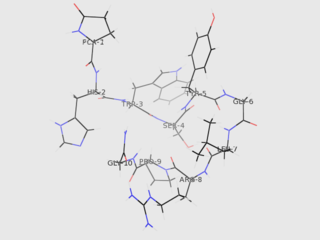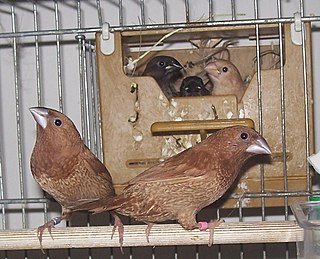Related Research Articles

Forkhead box protein P2 (FOXP2) is a protein that, in humans, is encoded by the FOXP2 gene. FOXP2 is a member of the forkhead box family of transcription factors, proteins that regulate gene expression by binding to DNA. It is expressed in the brain, heart, lungs and digestive system.

Bird vocalization includes both bird calls and bird songs. In non-technical use, bird songs are the bird sounds that are melodious to the human ear. In ornithology and birding, songs are distinguished by function from calls.

The Australian zebra finch or chestnut-eared finch is the most common estrildid finch of Central Australia. It ranges over most of the continent, avoiding only the cool humid south and some areas of the tropical far north. The bird has been introduced to Puerto Rico and Portugal. Due to the ease of keeping and breeding the zebra finch in captivity, it has become Australia’s most widely studied bird; by 2010, it was the most studied captive model passerine species worldwide, by a considerable margin.

Gonadotropin-releasing hormone (GnRH) is a releasing hormone responsible for the release of follicle-stimulating hormone (FSH) and luteinizing hormone (LH) from the anterior pituitary. GnRH is a tropic peptide hormone synthesized and released from GnRH neurons within the hypothalamus. The peptide belongs to gonadotropin-releasing hormone family. It constitutes the initial step in the hypothalamic–pituitary–gonadal axis.

Known as the Society finch in North America and the Bengali finch or Bengalese finch elsewhere, Lonchura striata domestica is a domesticated finch not found in nature. It became a popular cage and trade bird after appearing in European zoos in the 1860s where it was imported from Japan. There have been many theories of the origin of domestication for the Bengalese finch, and we now know it took place primarily in Japan. Coloration and behavior were modified through centuries of selection in Asia, then later in Europe and North America.

Neurotensin is a 13 amino acid neuropeptide that is implicated in the regulation of luteinizing hormone and prolactin release and has significant interaction with the dopaminergic system. Neurotensin was first isolated from extracts of bovine hypothalamus based on its ability to cause a visible vasodilation in the exposed cutaneous regions of anesthetized rats.
The KE family is a medical name designated for a British family, about half of whom exhibit a severe speech disorder called developmental verbal dyspraxia. It is the first family with speech disorder to be investigated using genetic analyses, by which the speech impairment is discovered to be due to genetic mutation, and from which the gene FOXP2, often dubbed the "language gene", was discovered. Their condition is also the first human speech and language disorder known to exhibit strict Mendelian inheritance.

Forkhead box protein P1 is a protein that in humans is encoded by the FOXP1 gene. FOXP1 is necessary for the proper development of the brain, heart, and lung in mammals. It is a member of the large FOX family of transcription factors.
The development of the nervous system in humans, or neural development or neurodevelopment involves the studies of embryology, developmental biology, and neuroscience to describe the cellular and molecular mechanisms by which the complex nervous system forms in humans, develops during prenatal development, and continues to develop postnatally.
Vocal learning is the ability to modify acoustic and syntactic sounds, acquire new sounds via imitation, and produce vocalizations. "Vocalizations" in this case refers only to sounds generated by the vocal organ as opposed to by the lips, teeth, and tongue, which require substantially less motor control. A rare trait, vocal learning is a critical substrate for spoken language and has only been detected in eight animal groups despite the wide array of vocalizing species; these include humans, bats, cetaceans, pinnipeds, elephants, and three distantly related bird groups including songbirds, parrots, and hummingbirds. Vocal learning is distinct from auditory learning, or the ability to form memories of sounds heard, a relatively common trait which is present in all vertebrates tested. For example, dogs can be trained to understand the word "sit" even though the human word is not in its innate auditory repertoire. However, the dog cannot imitate and produce the word "sit" itself as vocal learners can.

Angela Friederici is a director at the Max Planck Institute for Human Cognitive and Brain Sciences in Leipzig, Germany, and is an internationally recognized expert in neuropsychology and linguistics. She is the author of over 400 academic articles and book chapters, and has edited 15 books on linguistics, neuroscience, language and psychology.
Michale Sean Fee is an American neuroscientist who works on the neural mechanisms of sequence generation and learning. Michale Fee is faculty in the Department of Brain and Cognitive Sciences at the Massachusetts Institute of Technology, and an Investigator in the McGovern Institute for Brain Research. His laboratory studies how songbirds generate and learn complex vocal sequences.
Language has a long evolutionary history and is closely related to the brain, but what makes the human brain uniquely adapted to language is unclear. The regions of the brain that are involved in language in humans have similar analogues in apes and monkeys, and yet they do not use language. There may also be a genetic component: mutations in the FOXP2 gene prevent humans from constructing complete sentences.

Developmental verbal dyspraxia (DVD), also known as childhood apraxia of speech (CAS) and developmental apraxia of speech (DAS), is a condition in which an individual have problems saying sounds, syllables and words. This is not because of muscle weakness or paralysis. The brain has problems planning to move the body parts needed for speech. The individual knows what they want to say, but their brain has difficulty coordinating the muscle movements necessary to say those words.
The development of an animal model of autism is one approach researchers use to study potential causes of autism. Given the complexity of autism and its etiology, researchers often focus only on single features of autism when using animal models.

GnRH neurons, or gonadotropin-releasing hormone expressing neurons, are the cells in the brain that control the release of reproductive hormones from the pituitary. These brain cells control reproduction by secreting GnRH into the hypophyseal portal capillary bloodstream, so are sometimes referred to as “sex neurons”. This small capillary network carries GnRH to the anterior pituitary, causing release of luteinizing hormone (LH) and follicle stimulating hormone (FSH) into the wider bloodstream. When GnRH neurons change their pattern of release from the juvenile to the adult pattern of GnRH secretion, puberty is initiated. Failure of GnRH neurons to form the proper connections, or failure to successfully stimulate the pituitary with GnRH, means that puberty is not initiated. These disruptions to the GnRH system cause reproductive disorders like hypogonadotropic hypogonadism or Kallmann Syndrome.
Russell D. Fernald is an American neuroscientist/neuroethologist, currently on the Biology faculty at Stanford University. Fernald is known for his interdisciplinary work based on fieldwork and subsequent neuroethological analysis of an African cichlid fish that he has shown to be a useful and novel model organism. His research spans several domains: 1) in the visual system including the discovery of rod photoreceptor stem cells, circadian renewal of photoreceptor opsins and mechanisms of crystalline lens focus ; 2) In social control of reproductive behavior: social regulation of reproduction via gonadotropin releasing hormones through specific brain circuitry; 3) Cognitive skills that have evolved to regulate social status.
Sarah M. N. Woolley is a neuroscientist and Professor of Psychology at Columbia University's Zuckerman Institute. Her work centers on the neuroscience of communication, using songbirds to understand how the brain learns and understands vocal communication.
Constance Scharff, Ph.D., is a German zoologist and neuroethologist and Professor at the Free University of Berlin. She is particularly notable for her research on birdsong, neurogenesis and regeneration.
Sonja Catherine Vernes is a neuroscientist who is, as of 2022, the head of the Neurogenetics of Vocal Communication Research Group at the University of St Andrews. She holds a UK Research and Innovation (UKRI) future leaders fellowship. Her research investigates vocal communication between mammals. She was a laureate for the 2022 Blavatnik Awards for Young Scientists.
References
- 1 2 3 Andrewtran. "Stephanie White". Integrative Biology and Physiology. Retrieved 2021-06-20.
- ↑ White, Stephanie Ann (1997). Social control of gonadotropin-releasing hormone gene expression (Thesis). OCLC 80935553.
- ↑ "ORCID: Stephanie White". orcid.org. Retrieved 2021-09-30.
{{cite web}}: CS1 maint: url-status (link) - 1 2 3 "Bird's song may be linked to speech disorders". EurekAlert!. Retrieved 2021-06-20.
- ↑ Andrewtran. "Stephanie White". Integrative Biology and Physiology. Retrieved 2021-09-30.
- 1 2 3 "CART pilot grant recipient to study songbird model for disorders of communication | Semel Institute for Neuroscience and Human Behavior". www.semel.ucla.edu. Retrieved 2021-06-20.
- ↑ "Stephanie White – UCLA Graduate Programs in Bioscience (GPB)" . Retrieved 2021-06-20.
- ↑ "Scientists ID 2,000 genes in zebra finch brain linked to singing: May teach us about human speech disorders". ScienceDaily. Retrieved 2021-06-20.
- ↑ "A bird's song may teach us about human speech disorders". phys.org. Retrieved 2021-06-20.